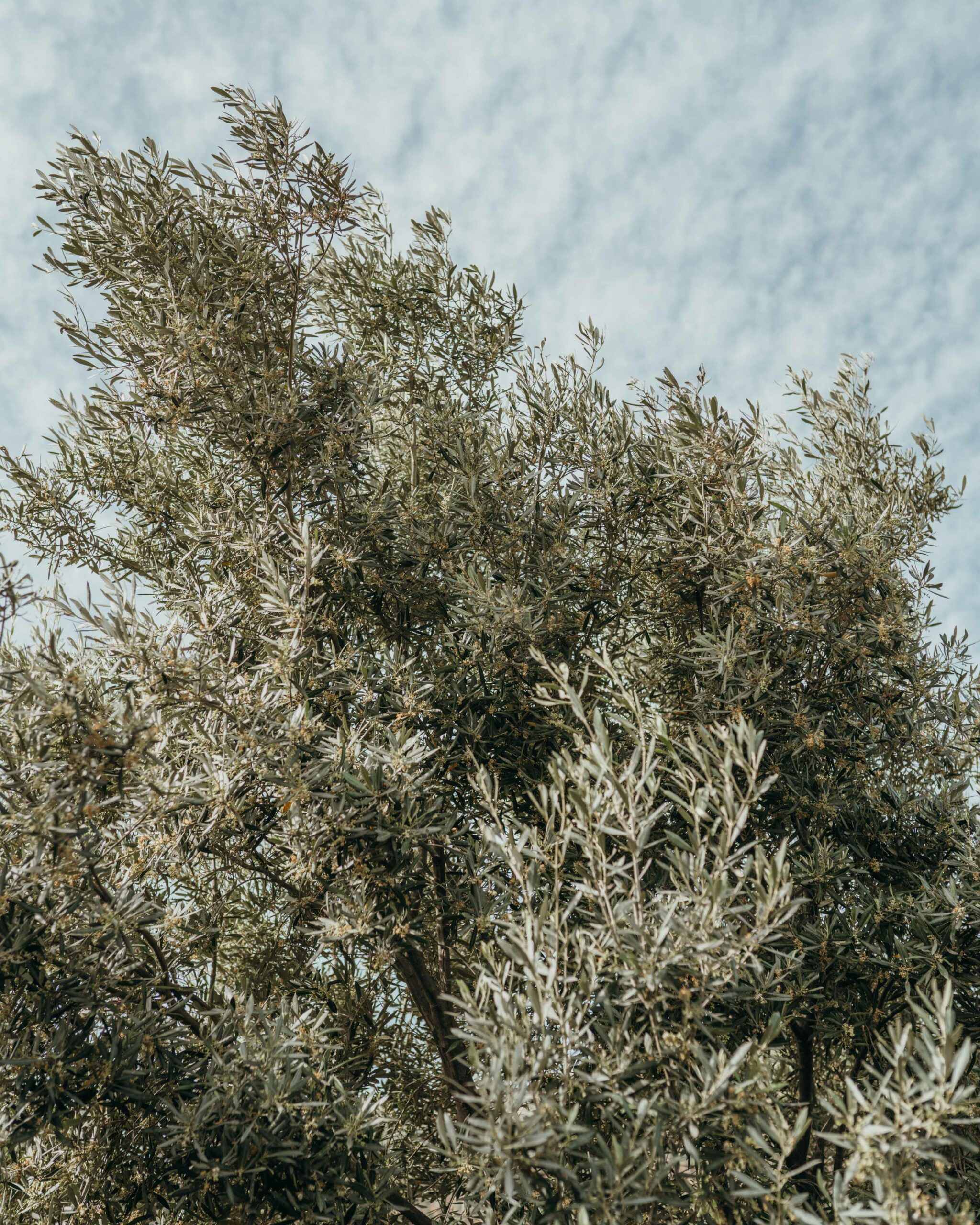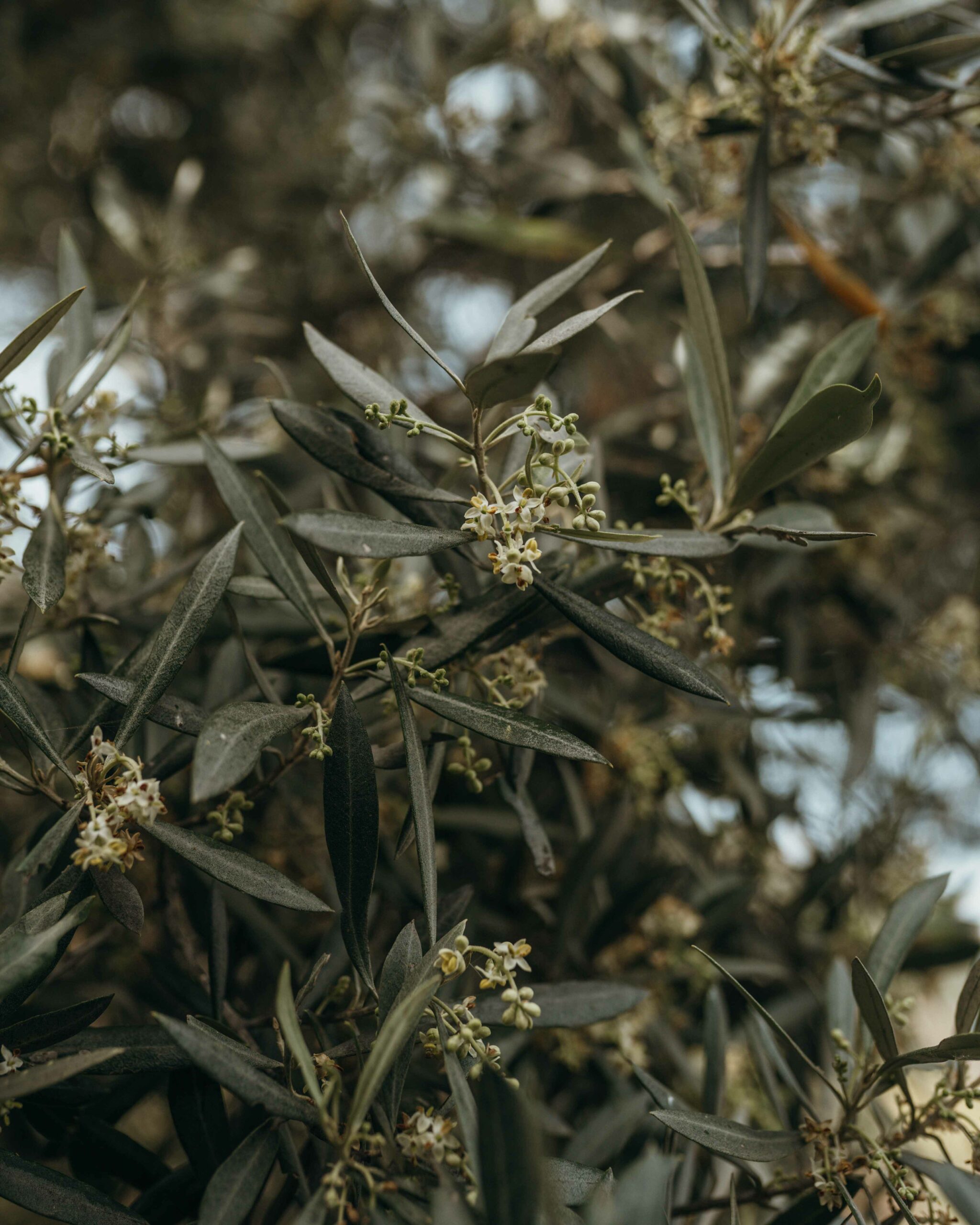Olea europaea
Olive
Englische Bezeichnung: Olive
Spanische Bezeichnung: Oliva
Familie
Ölbaumgewächse (Oleaceae)
Hauptbestandteile:
Fette (Frucht): Ölsäure, Palmitinsäure, Linolsäure
Vitamine: B-Vitamine, E
Sekundäre Pflanzenstoffe:
-
Frucht: Antioxidatien, Phenolverbindungen (Oleuropein, Tyrosol, Hydroxytyrosol, Oleocanthal), Flavonoide (Apigenin, Luteolin Quercetin), Hydroxyzimtsäuren (Kaffeesäure, Kuminsäure), Anthocyanidine (Cyanidine, Peonidine), Hydroxybenzoesäure (Gallussäure, Vanillinsäure)
-
Blätter: Secoiridoid-Monoterpene (z.B. Oleuropein), Triterpenoide, Flavonoide, Hydroxytyrosol
Ernte-Hinweise:
-
Früchte: Oliven werden traditionell per Hand geerntet, wobei sich die Früchte umso leichter lösen lassen, je reifer sie sind. Diese können einfach vom Baum gepflückt werden. Olivenbauern schlagen die Früchte oft mit Rechen oder Stöcken von den Zweigen.
-
Blätter: Um den höchsten Gehalt an aktiven Phytochemikalien, insbesondere Oleuropein, zu erhalten, erntet man im Herbst und vermeidet heiße Tage. Die Blätter können Staub ansammeln; daher wäscht man Sie sie sanft vor der Verwendung.
Verwendung:
Frucht: Antipasti, Tapa, auf Pizza, zu Pasta, Schoko-Dessert
Blätter: Tee, Sud, Tinktur, Pulver
Oliven werden im Mittelmeerraum seit der Bronzezeit (vor 4.000 Jahren) kultiviert. Archäologische Funde von Olivenkernen haben jedoch gezeigt, dass wilde Oliven schon vor mindestens 9.000 Jahren gegessen wurden.
Auch heute noch nutzt man den Olivenbaum sehr vielseitig: Sein Holz ist ein vorzüglicher Brennstoff und kann überdies aufgrund seiner Härte zu den unterschiedlichsten Gegenständen verarbeitet werden. Am Anfang ist jede Olive grün. Mit zunehmendem Reifegrad nehmen die Früchte dann eine violette, braune oder schwarze Färbung an.
Jedoch werden die meisten Oliven von der Lebensmittelindustrie nur schwarz eingefärbt (mithilfe von Eisensalzen, den Farbstoffen Eisen-II-Gluconat (E 579) und Eisen-II-Lactat (E 585)). Warum dies geschieht, ist schnell erklärt: Schwarze Oliven müssen meist länger am Baum bleiben, sind somit auch eher anfällig für Schädlinge und Witterungseinflüsse.
Die Wirkungsweisen der Blätter schätzte man schon in der Antike, unter anderem zur Stärkung des Immunsystems, bei Bluthochdruck, bei Schlafstörungen oder Nervosität. Um den Leichnam vor Pilz-, Bakterien und Parasitenbefall zu schützen, wurden im Alten Ägypten auch gepresste Olivenblätter beim Mumifizieren verwendet.
Family
Olive family (Oleaceae)
Main components:
Fats (fruit): Oleic acid, palmitic acid, linoleic acid
Vitamins: B vitamins, E
Secondary plant compounds:
Fruit: Antioxidants, phenolic compounds (oleuropein, tyrosol, hydroxytyrosol, oleocanthal), flavonoids (apigenin, luteolin quercetin), hydroxycinnamic acids (caffeic acid, coumic acid), anthocyanidins (cyanidins, peonidins), hydroxybenzoic acid (gallic acid, vanillic acid).
Leaves: secoiridoid monoterpenes (e.g. oleuropein), triterpenoids, flavonoids, hydroxytyrosol
Harvesting guideline:
-
Fruit: Olives are traditionally harvested by hand, and the riper the fruit, the easier it is to loosen. These can simply be picked from the tree. Olive farmers often beat the fruit from the branches with rakes or sticks.
Leaves: To get the highest content of active phytochemicals, especially oleuropein, harvest in autumn and avoid hot days. The leaves can collect dust; so wash them gently before use.
Use:
Fruit: Antipasti, tapa, on pizza, with pasta, chocolate dessert.
Leaves: tea, decoction, tincture, powder
Olives have been cultivated in the Mediterranean region since the Bronze Age (4,000 years ago). However, archaeological finds of olive stones have shown that wild olives were eaten at least 9,000 years ago.
Even today, the olive tree is used in many different ways: its wood is an excellent fuel and, because of its hardness, can be made into a wide variety of objects. At the beginning, every olive is green. As they ripen, the fruits take on a purple, brown or black colour.
However, most olives are only coloured black by the food industry (with the help of iron salts, the colourants iron II gluconate (E 579) and iron II lactate (E 585)). Why this happens is quickly explained: black olives usually have to stay on the tree longer and are therefore more susceptible to pests and the effects of the weather.
The effects of the leaves were already appreciated in antiquity, among other things for strengthening the immune system, for high blood pressure, for sleep disorders or nervousness. In order to protect the corpse from fungal, bacterial and parasitic infestation, pressed olive leaves were also used for mummification in Ancient Egypt.
Familia
Familia del olivo (Oleaceae)
Componentes principales:
Grasas (fruta): Ácido oleico, ácido palmítico, ácido linoleico
Vitaminas: Vitaminas B, E
Compuestos vegetales secundarios:
Fruto: Antioxidantes, compuestos fenólicos (oleuropeína, tirosol, hidroxitirosol, oleocanthal), flavonoides (apigenina, luteolina quercetina), ácidos hidroxicinámicos (ácido cafeico, ácido cúmico), antocianidinas (cianidinas, peonidinas), ácido hidroxibenzoico (ácido gálico, ácido vanílico).
Hojas: monoterpenos secoiridoides (por ejemplo, oleuropeína), triterpenoides, flavonoides, hidroxitirosol.
Guía de cosecha:
-
El fruto: Las aceitunas se recolectan tradicionalmente a mano, y cuanto más maduro esté el fruto, más fácil es soltarlo. Éstos pueden recogerse simplemente del árbol. Los olivicultores suelen golpear los frutos de las ramas con rastrillos o palos.
Las hojas: Para obtener el mayor contenido de fitoquímicos activos, especialmente oleuropeína, recójalas en otoño y evite los días calurosos. Las hojas pueden acumular polvo, por lo que hay que lavarlas suavemente antes de utilizarlas.
Uso:
Frutas: Antipasti, tapa, sobre pizza, con pasta, postre de chocolate.
Hojas: té, decocción, tintura, polvo.
Las aceitunas se cultivan en la región mediterránea desde la Edad de Bronce (hace 4.000 años). Sin embargo, los hallazgos arqueológicos de huesos de aceituna han demostrado que ya se comían aceitunas silvestres hace al menos 9.000 años.
Incluso hoy en día, el olivo se utiliza de muchas maneras diferentes: su madera es un excelente combustible y, debido a su dureza, se puede convertir en una gran variedad de objetos. Al principio, todas las aceitunas son verdes. A medida que maduran, los frutos adquieren un color púrpura, marrón o negro.
Sin embargo, la mayoría de las aceitunas sólo se colorean de negro en la industria alimentaria (con la ayuda de sales de hierro, los colorantes gluconato de hierro II (E 579) y lactato de hierro II (E 585)). La razón de ello se explica rápidamente: las aceitunas negras suelen tener que permanecer más tiempo en el árbol y, por lo tanto, son más susceptibles a las plagas y a los efectos de la intemperie.
Los efectos de las hojas ya eran apreciados en la antigüedad, entre otras cosas para reforzar el sistema inmunitario, para la hipertensión arterial, para los trastornos del sueño o el nerviosismo. Para proteger el cadáver de la infestación por hongos, bacterias y parásitos, en el Antiguo Egipto también se utilizaban hojas de olivo prensadas para la momificación.








































